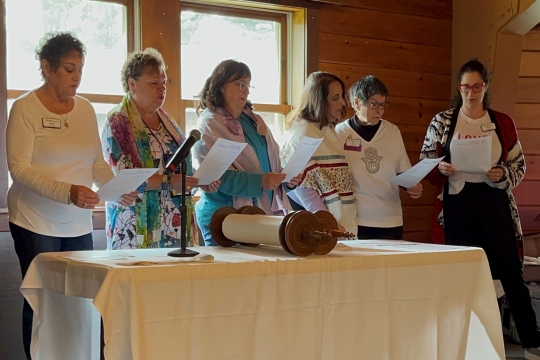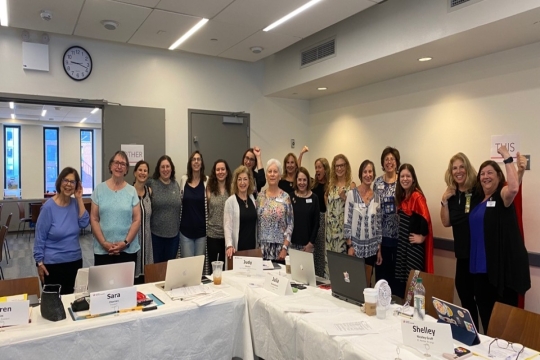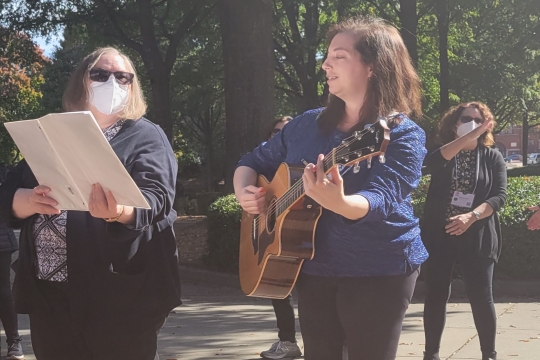by Lyn Feldman
This week's Torah portion, T'tzaveh, talks about the construction of the priestly garments, particularly the clothing of the high priest Aaron, that are to be worn in the Tabernacle. The parashah also describes the ordination of the priests, a necessary step before the Tabernacle can start to function, and discusses the sacrifices that will take place there.
One aspect of this parashah that I would like to examine is the exclusion of women from the Israelite priesthood and how this has unfolded in contemporary times.
Exodus 28:4 states, “They shall make those sacral vestments for your brother Aaron and his sons, for priestly service to Me.” This text has been construed to mean that only Aaron and his sons will serve as priests to G-d in the Tabernacle —not men from any other familial line and not women.
While Jewish women have always held leadership roles in their communities, they were excluded from positions of religious leadership.
Clearly we have ceased to interpret this text as an injunction against women in the rabbinate. The narrow interpretation has made way for a more liberal and inclusive understanding.
In this Centennial year for Women of Reform Judaism (WRJ), it is both inspiring and illuminating to briefly examine events leading up to the ordination of women. The National Federation of Temple Sisterhoods (NFTS, now WRJ) promoted the equality of women in Jewish life since its inception in 1913. Its founding president, Carrie O. Simon, was an outspoken advocate for the ordination of women. Dr. Jane Evans, the first executive director of NFTS, carried on Simon's campaign. After years of hard work and advocacy, Evans brought the issue to the agenda of the NFTS 50th Anniversary biennial in 1963 and the resolution was adopted calling for the ordination of women.
Almost 10 years later in 1972, Sally Priesand graduated from and was ordained by HUC-JIR. During her ordination ceremony, Priesand's classmates gave her a standing ovation.
While Priesand was the first woman to be ordained by a seminary, it is important and moving to recognize that Regina Jonas of Berlin was the first woman to be privately ordained as a rabbi. In a 1938 letter, Jonas wrote, “God has placed abilities and callings in our hearts without regard to gender”. Tragically, Regina Jonas was killed in Auschwitz in 1944 at the age of 42.
Carolyn Bricklin challenges us in this week’s WRJ Torah Study Guide to try to remember a time when there were no female clergy and to consider what has been the impact of the ordination of women on our Jewish community.
This question personally resonates with me. Growing up in a small community in Canada where there were no female clergy at our synagogue, I did not have the benefit of religious female leaders as role models. It was not until I was married and joined Holy Blossom Temple in Toronto that I was able to experience the power of studying and learning with women rabbis.
Recently, I have had the honour of being a reader for the NFTY essay writing competition commemorating WRJ's Centennial. NFTY students submitted essays on 'The Influence of Women's Leadership on Our Congregations.' I was overwhelmed by the number of essays in which teenage girls talked about the positive impact that their female rabbis had on them as role models, teachers, and mentors. I was struck by the fact that these girls are on a much different journey than I was growing up. Now, many of them may contemplate becoming our future religious leaders.
WRJ supports the ordination of women through our YES (Youth, Education, and Special Projects) fund. Through this fund, we provide scholarships for men and women to study at the HUC campuses and go on to the rabbinate. WRJ's influence in this respect is significant in my own community, where the presence of women in the rabbinate is a relatively newer tradition. A rabbi at my synagogue in Toronto, Rabbi Karen Thomashow, has recognized this influence in a WRJ Y.E.S. Fund presentation which quoted her as saying, “The WRJ... has supported the growth of the rabbinate and the movement through its sensitive acknowledgement that the female rabbi is a role that is still growing, especially in Canada.”
As we reflect on the past 100 years we can feel proud of our journey. Our daughters and granddaughters will grow up with female clergy as role models in their communities. When they read biblical stories, they will know that there is a religious role for women to play. For those who dream of fulfilling that role, they will know that there is a clear path to the realization of their dream.
Lyn Feldman is a WRJ Board Member and member of Holy Blossom Temple in Toronto, ON, Canada.
Related Posts
Image

Parashat Yom Rishon shel Rosh HaShanah
September 14, 2023
During the High Holidays, my thoughts turn to the special blessings, prayers, and melodies that shape our journey from Selichot to Rosh HaShanah to the final shofar blast on Yom Kippur. Many of our prayers in the High Holiday liturgy are written in the plural.
Image

Cultivating a Culture of Accountability and Belonging
September 8, 2023
And, we’re off! Many of us have worked over the summer with friends and colleagues to set the calendar for the year ahead, including meetings, events, and other opportunities for gathering.
Image

My Journey from Altar-Girl to Cantorial Soloist
August 11, 2023
I was born a Goldman, and always knew I was Jewish on my dad’s side. Although my whole family was spiritual in their own way, the Jewish side of my family didn’t have warm feelings towards religion, and the only thing passed down to me was the Jewish humor I grew up in New Jersey and had an open...
